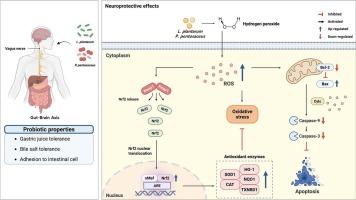Neuroprotective effects of Lactiplantibacillus plantarum and Pediococcus pentosaceus strains against oxidative stress via modulation of Nrf2-mediated antioxidation and anti-apoptosis
IF 2.6
4区 医学
Q3 NEUROSCIENCES
引用次数: 0
Abstract
Oxidative stress leads to neurodegenerative diseases such as Parkinson’s, Alzheimer’s, and Huntington’s diseases. Therefore, we isolated Lactiplantibacillus plantarum and Pediococcus pentosaceus strains from kimchi and investigated the neuroprotective effects of the heat-killed lactic acid bacteria (LAB) strains against oxidative stress. All LAB strains demonstrated suitable probiotic characteristics. The heat-killed LAB strains exhibited strong antioxidant activities by effectively scavenging free radicals. To mimic gut–brain axis communication, conditioned medium (CM) was generated by incubating the heat-killed LAB strains with HT-29 intestinal cells. The LAB-CM was then applied to SH-SY5Y neuroblastoma cells to evaluate their neuroprotective effects against oxidative stress. The LAB-CM protected SH-SY5Y cells against hydrogen peroxide (H2O2)-induced oxidative stress, as evidenced by improved cell viability, reduced lactate dehydrogenase (LDH) release, morphological preservation, and suppression of reactive oxygen species (ROS) production. The heat-killed LAB strains enhanced brain-derived neurotrophic factor (BDNF) and tyrosine hydroxylase (TH) mRNA expression in HT-29 cells, contributing to increased BDNF and TH levels in the LAB-CM. Furthermore, the LAB-CM activated Kelch-like ECH-associated protein 1 (Keap1)/Nuclear factor erythroid 2-related factor 2 (Nrf2)/Heme oxygenase-1 (HO-1) signaling pathway, increasing the expression of antioxidant enzymes, including NAD(P)H quinone oxidoreductase 1 (NQO1), thioredoxin reductase 1 (TXNRD1), superoxide dismutase 1 (SOD1), and catalase (CAT). It also modulated Bcl-2-associated X protein (Bax)/B-cell lymphoma 2 (Bcl-2) and inhibited the activation of cysteine-aspartic acid protease-9 (caspase-9) and caspase-3, thereby alleviating oxidative stress-induced neuronal apoptosis. Thus, L. plantarum WB3809 and P. pentosaceus WB3812 have the potential to be used as functional food ingredients with neuroprotective effects via antioxidant and anti-apoptotic mechanisms.

通过调控nrf2介导的抗氧化和抗凋亡,植物乳杆菌和戊糖Pediococcus对氧化应激的神经保护作用。
氧化应激导致神经退行性疾病,如帕金森病、阿尔茨海默病和亨廷顿病。因此,我们从泡菜中分离出植物乳杆菌和戊糖Pediococcus,并研究了它们的热杀乳酸菌(LAB)对氧化应激的神经保护作用。所有LAB菌株均表现出良好的益生菌特性。热灭LAB菌株通过清除自由基表现出较强的抗氧化活性。为了模拟肠-脑轴通讯,通过热灭活LAB菌株与HT-29肠细胞孵育产生条件培养基(CM)。然后将CM应用于SH-SY5Y神经母细胞瘤细胞,以评估其对氧化应激的神经保护作用。LAB-CM可保护SH-SY5Y神经母细胞瘤细胞免受过氧化氢(H2O2)诱导的氧化应激,其表现为提高细胞活力、减少乳酸脱氢酶(LDH)释放、形态保存和抑制活性氧(ROS)产生。热灭活LAB菌株增强HT-29细胞中脑源性神经营养因子(BDNF)和酪氨酸羟化酶(TH) mRNA表达,导致LAB- cm中BDNF和TH水平升高。此外,LAB-CM激活Kelch-like ECH-associated protein 1 (Keap1)/Nuclear factor erythroid 2-related factor 2 (Nrf2)/Heme oxygenase-1 (HO-1)信号通路,增加NAD(P)H醌氧化还原酶1 (NQO1)、硫氧还蛋白还原酶1 (TXNRD1)、超氧化物歧化酶1 (SOD1)、过氧化氢酶(CAT)等抗氧化酶的表达。它还能调节Bcl-2相关的 X 蛋白(BAX)/ b细胞淋巴瘤2 (Bcl-2),抑制半胱氨酸-天冬氨酸蛋白酶9 (caspase-9)和caspase-3的激活,从而减轻氧化应激诱导的神经元凋亡。因此,L. plantarum WB3809和P. pentosaceus WB3812具有通过抗氧化和抗凋亡机制发挥神经保护作用的功能性食品成分潜力。
本文章由计算机程序翻译,如有差异,请以英文原文为准。
求助全文
约1分钟内获得全文
求助全文
来源期刊

Brain Research
医学-神经科学
CiteScore
5.90
自引率
3.40%
发文量
268
审稿时长
47 days
期刊介绍:
An international multidisciplinary journal devoted to fundamental research in the brain sciences.
Brain Research publishes papers reporting interdisciplinary investigations of nervous system structure and function that are of general interest to the international community of neuroscientists. As is evident from the journals name, its scope is broad, ranging from cellular and molecular studies through systems neuroscience, cognition and disease. Invited reviews are also published; suggestions for and inquiries about potential reviews are welcomed.
With the appearance of the final issue of the 2011 subscription, Vol. 67/1-2 (24 June 2011), Brain Research Reviews has ceased publication as a distinct journal separate from Brain Research. Review articles accepted for Brain Research are now published in that journal.
 求助内容:
求助内容: 应助结果提醒方式:
应助结果提醒方式:


